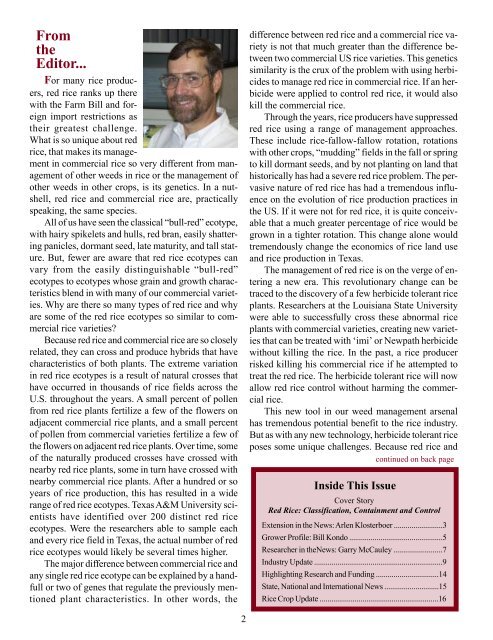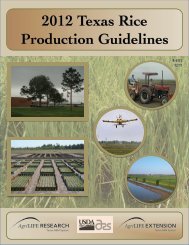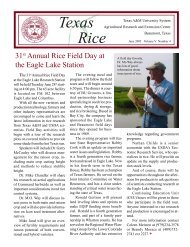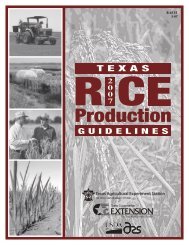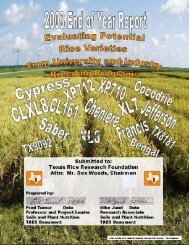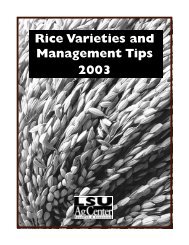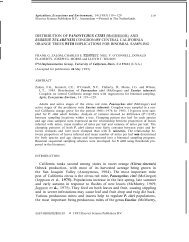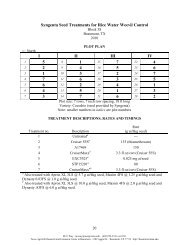Texas Rice - Texas A&M AgriLIFE Research Center at Beaumont ...
Texas Rice - Texas A&M AgriLIFE Research Center at Beaumont ...
Texas Rice - Texas A&M AgriLIFE Research Center at Beaumont ...
You also want an ePaper? Increase the reach of your titles
YUMPU automatically turns print PDFs into web optimized ePapers that Google loves.
From<br />
the<br />
Editor...<br />
For many rice producers,<br />
red rice ranks up there<br />
with the Farm Bill and foreign<br />
import restrictions as<br />
their gre<strong>at</strong>est challenge.<br />
Wh<strong>at</strong> is so unique about red<br />
rice, th<strong>at</strong> makes its management<br />
in commercial rice so very different from management<br />
of other weeds in rice or the management of<br />
other weeds in other crops, is its genetics. In a nutshell,<br />
red rice and commercial rice are, practically<br />
speaking, the same species.<br />
All of us have seen the classical “bull-red” ecotype,<br />
with hairy spikelets and hulls, red bran, easily sh<strong>at</strong>tering<br />
panicles, dormant seed, l<strong>at</strong>e m<strong>at</strong>urity, and tall st<strong>at</strong>ure.<br />
But, fewer are aware th<strong>at</strong> red rice ecotypes can<br />
vary from the easily distinguishable “bull-red”<br />
ecotypes to ecotypes whose grain and growth characteristics<br />
blend in with many of our commercial varieties.<br />
Why are there so many types of red rice and why<br />
are some of the red rice ecotypes so similar to commercial<br />
rice varieties?<br />
Because red rice and commercial rice are so closely<br />
rel<strong>at</strong>ed, they can cross and produce hybrids th<strong>at</strong> have<br />
characteristics of both plants. The extreme vari<strong>at</strong>ion<br />
in red rice ecotypes is a result of n<strong>at</strong>ural crosses th<strong>at</strong><br />
have occurred in thousands of rice fields across the<br />
U.S. throughout the years. A small percent of pollen<br />
from red rice plants fertilize a few of the flowers on<br />
adjacent commercial rice plants, and a small percent<br />
of pollen from commercial varieties fertilize a few of<br />
the flowers on adjacent red rice plants. Over time, some<br />
of the n<strong>at</strong>urally produced crosses have crossed with<br />
nearby red rice plants, some in turn have crossed with<br />
nearby commercial rice plants. After a hundred or so<br />
years of rice production, this has resulted in a wide<br />
range of red rice ecotypes. <strong>Texas</strong> A&M University scientists<br />
have identified over 200 distinct red rice<br />
ecotypes. Were the researchers able to sample each<br />
and every rice field in <strong>Texas</strong>, the actual number of red<br />
rice ecotypes would likely be several times higher.<br />
The major difference between commercial rice and<br />
any single red rice ecotype can be explained by a handfull<br />
or two of genes th<strong>at</strong> regul<strong>at</strong>e the previously mentioned<br />
plant characteristics. In other words, the<br />
difference between red rice and a commercial rice variety<br />
is not th<strong>at</strong> much gre<strong>at</strong>er than the difference between<br />
two commercial US rice varieties. This genetics<br />
similarity is the crux of the problem with using herbicides<br />
to manage red rice in commercial rice. If an herbicide<br />
were applied to control red rice, it would also<br />
kill the commercial rice.<br />
Through the years, rice producers have suppressed<br />
red rice using a range of management approaches.<br />
These include rice-fallow-fallow rot<strong>at</strong>ion, rot<strong>at</strong>ions<br />
with other crops, “mudding” fields in the fall or spring<br />
to kill dormant seeds, and by not planting on land th<strong>at</strong><br />
historically has had a severe red rice problem. The pervasive<br />
n<strong>at</strong>ure of red rice has had a tremendous influence<br />
on the evolution of rice production practices in<br />
the US. If it were not for red rice, it is quite conceivable<br />
th<strong>at</strong> a much gre<strong>at</strong>er percentage of rice would be<br />
grown in a tighter rot<strong>at</strong>ion. This change alone would<br />
tremendously change the economics of rice land use<br />
and rice production in <strong>Texas</strong>.<br />
The management of red rice is on the verge of entering<br />
a new era. This revolutionary change can be<br />
traced to the discovery of a few herbicide tolerant rice<br />
plants. <strong>Research</strong>ers <strong>at</strong> the Louisiana St<strong>at</strong>e University<br />
were able to successfully cross these abnormal rice<br />
plants with commercial varieties, cre<strong>at</strong>ing new varieties<br />
th<strong>at</strong> can be tre<strong>at</strong>ed with ‘imi’ or Newp<strong>at</strong>h herbicide<br />
without killing the rice. In the past, a rice producer<br />
risked killing his commercial rice if he <strong>at</strong>tempted to<br />
tre<strong>at</strong> the red rice. The herbicide tolerant rice will now<br />
allow red rice control without harming the commercial<br />
rice.<br />
This new tool in our weed management arsenal<br />
has tremendous potential benefit to the rice industry.<br />
But as with any new technology, herbicide tolerant rice<br />
poses some unique challenges. Because red rice and<br />
continued on back page<br />
Inside This Issue<br />
Cover Story<br />
Red <strong>Rice</strong>: Classific<strong>at</strong>ion, Containment and Control<br />
Extension in the News: Arlen Klosterboer .........................3<br />
Grower Profile: Bill Kondo ................................................5<br />
<strong>Research</strong>er in theNews: Garry McCauley .........................7<br />
Industry Upd<strong>at</strong>e ..................................................................9<br />
Highlighting <strong>Research</strong> and Funding ................................14<br />
St<strong>at</strong>e, N<strong>at</strong>ional and Intern<strong>at</strong>ional News ............................15<br />
<strong>Rice</strong> Crop Upd<strong>at</strong>e .............................................................16<br />
2


